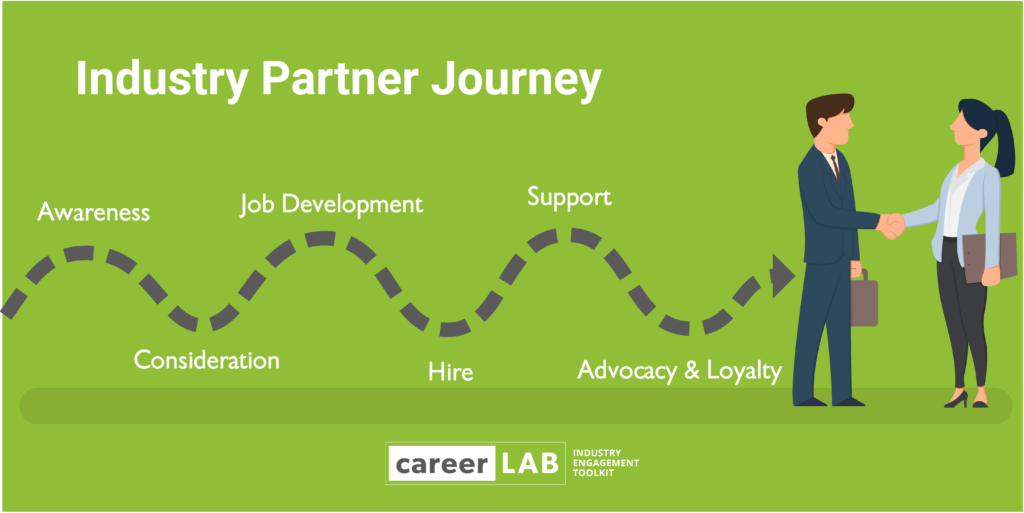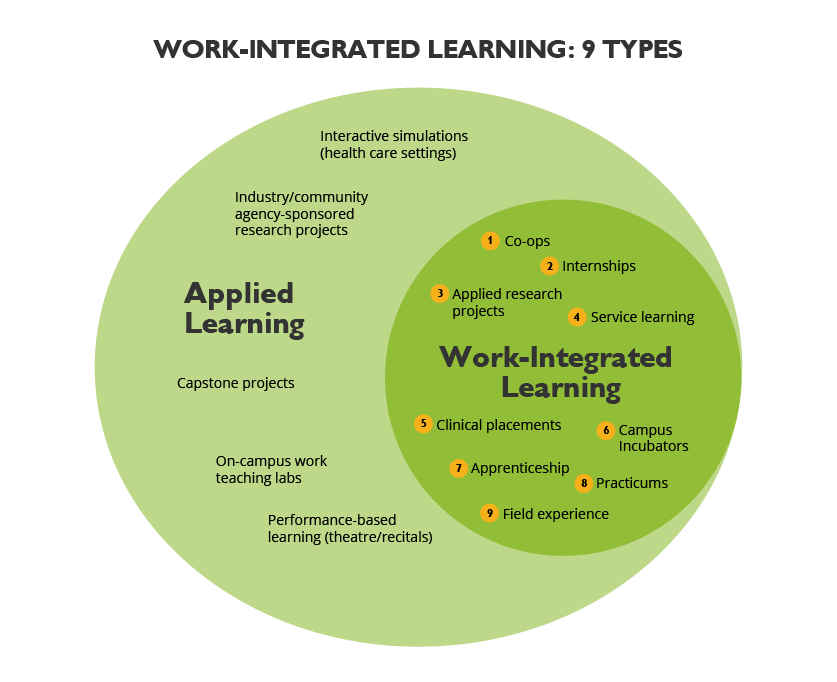Overview: From placements to partners
Employer engagement is not “job placement” work, nor is it synonymous with email marketing to employers.
Recent research has identified the following challenges employers face when considering involvement in WIL; associated cost, insufficient resources and support, complexity of partnering with Post-Secondary institutions and limited, confusing information about WIL (Patrick et al., 2014; PhillipsKPA, 2014; Smith et al., 2014).
An engagement process over time.
Educational institutions recognize that strong relationships with businesses are essential in placing students into co-ops, internships, applied research projects, and ultimately sustainable careers. Work-integrated learning opportunities are critical for developing the skilled workforce that Canada needs, but this would not be possible without industry involvement.
Work-integrated learning, often misunderstood by employers (PhillipsKPA, 2014), is a broad term for education that combines academics and its practical applications. It is a workplace experience that is structured and intentional – an engagement between student, post-secondary institution and workplace, between theory and practice, between formal learning and productive work.

Partnerships
Employer involvement in WIL is not “job placement” work, nor is it synonymous with “mass email marketing to employers.” Similarly, WIL is not a “summer job”. Successful employer involvement that is fostered by regular personalized engagement translates into partnerships of mutual support and understanding between educational programs and employers. This engagement strategy recognizes that employers require practical and educational resources along their WIL participation journey. Surveys show that employers typically understand the value of participating in WIL but hesitate to hire a student employee because of:
- The perceived time involved
- Associated cost
- Lack of understanding about role and responsibilities
- Insufficient resources and support
- Complexity in partnering with PSI’s
- Limited, confusing information about WIL
The Job Developer’s role
A job developer’s role is complex and demanding. It’s a balancing act that must satisfy the institution, the employers, and student job seekers. Job development requires meeting new people every day, earning their trust, discussing their businesses, and becoming involved in their working and, often, their personal lives. It requires learning what employers need, understanding student skills and competencies, knowledge of program timelines, and federal and provincial funding programs. In essence, job development is persistence, personalization, and prospecting – relationship building.
Job developers target, connect, and engage with current and potential industry partner contacts on a mutually beneficial value proposition. Through an ongoing consultative process, they educate and support, which ultimately leads to increased involvement.
Solving a problem
Job development is both marketing and selling. It requires connecting with specific people in certain organizations in a customized way and pitching them on how our services can help them solve a problem. Sometimes the problem is to fill short-term hiring gaps in a cost-effective way or have year-end and peak period demands. However, surveys show that the number one reason employers participate in WIL is to develop the skills their organization and industry need.
Top 5 reasons organizations participate in WIL
- Develop specific skills their organization and industry need
- Access specific skills or talents
- Pre-screen potential new hires
- Give back to the community
- Manage short-term pressures or special projects
Finding skilled talent is a growing challenge
Canadian businesses face significant challenges when it comes to finding qualified talent with the right skill set in a timely manner, according to a 2019 BHER survey by the Business & Higher Education Roundtable and Business Council of Canada. Labour markets are shifting and organizations are requiring workers who have a different mix of skills and experiences. Covid-19 has only accelerated this challenge. A recent 2020 Statistics Canada survey reported that businesses expect increased challenges in recruiting qualified workers and finding the time and resources to train new staff in the coming year.

9 Types of WIL

WIL can be defined as “the process whereby students come to learn from experiences in educational and practice settings and integrate the contributions of those experiences in developing the understanding, procedures and dispositions required for effective practice” (Billet, 2015).
A structured & systematic approach to job development
Even the most dedicated, hard‐working job developers cannot contact every employer for every job. While effective job development is highly personalized through relationship building, it is the most successful when a structured and systematic approach is used. This toolkit provides you with both structure and resources to support your industry engagement initiatives that will save you time and offer the highest impact.
This Toolkit will enable you to:
- Do an internal employer assessment.
- Map out how employers currently engage with your services across key stages – employer journey map.
- Create employer personas based on your programs.
- Segment employers in a meaningful way.
- Understand system integration with employer segments.
- Set engagement objectives.
- Develop strategies for positioning that connect employers directly to your services.
- Create communication tactics and an implementation plan.
- Develop an employer engagement plan.
- Integrate federal and provincial funding into an important value-added service for your employers.
Hiring a student for the first time (prospective employers) can be daunting, time-consuming, and expensive for employers. Making it easier for industry to engage with PSI’s, offering clear supporting employer-centric resources, helping employers navigate funding and build upon personal relationship building practices are keys to building lifetime partners.
Toolkit Home
Section 1: Research & Analysis

